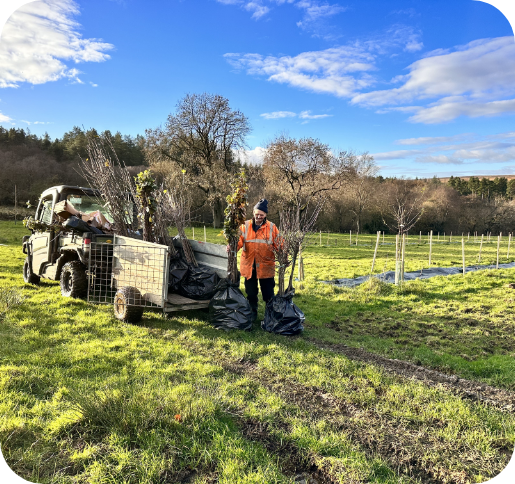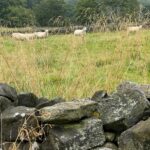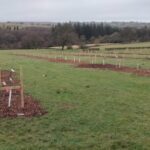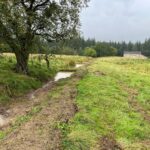LIVING LAB 7: United Kingdom
Biohub at Ings Farm (Circular regenerative demonstrator farm)
Managed by RegenFarmCo’
General information
The Biohub at Ings Farm is one of five farms actively participating in the North of England living lab. Located in North Yorkshire, England, the system in the early stages of development at just a year old, involves a design of multilayered rows of trees and perennial plants that are being integrated within a traditional upload pasture farm with existing hedgerows and patches of woodland. The farm has historically been reliant on sheep and silage as main sources of income.
The aim is to demonstrate the challenges and opportunities in applying agroforestry designs approach to a silvopasture system with an emphasis very much on building a multi-functional circular system. The intention is to mimic UK woodlands which typically have 7 layers, in a system of 7 lines and integrating other elements such as mycorrhizal fungi, woodchip inoculated with oyster mushroom spores (intended to mimic a woodland floor), and lob worms.
The lob worms are critical for soil aeration. The soil is generally very clay heavy with a history of becoming waterlogged. The worms dig deep into the soil, making permanent burrows which increases the soil porosity, giving nutrients and fertiliser easier access to the roots of plants, and helping to break soil mineral particles down into water-soluble nutrients. Perennial systems have association with mycorrhizal fungi and are capable of retuning carbon to the soil… The intention is to create a multi-functional system, stacking biological functionality whilst also stacking the economics of the system.
Dr Vincent Walsh designs and leads on the farm implementation and management of the Biohub demo site at Ings Farm, working closely with resident farmer Derek Greenwood. Derek has realised over the last 10 years that his way of farming wasn’t working for the land and he felt he should do something – he reduced the number of livestock as part of that, and collaborated with Yorkshire Water (who own the land) to participate in the project Vincent drew up, to help transition the farm into something potentially more sustainable. The demo site is also a collaboration between RegenFarmCo (founded by Vincent), Yorkshire Water, QuornProfessionals, and Levy (part of the Compass group). A supply chain has been established so that products can eventually be sold quickly. A key part of the picture is improving the hydrology on the farm and integrating that within the agroforestry system.
General farming approach
Regenerative circular design
Objectives
- Have a multi-functional system.
- Apply an ecosystems approach which is seen as being critical for ecological services, stacking economics, and to the cohort of partners brought together – it has to work for all of them.
Focus on the ecological services that can be got out of the system but also demonstrate the potential benefits of the whole design in the uplands. The system is based on biospheric principles – focusing on the hydrology, the integration of fungus, the stacking of photosynthesis capability, and the stacking of layers in the system.
Create new supply chains with a focus on perennial crops. A system is being put in place whereby food produced on the farm is sold by RegenFarmCo to the sister company Herblabism (plant based company), as part of a farm innovation programme with Levy (part of the Compass Group).
Have a ‘healthier’ circular system, environmentally and economically.
Create a better platform and healthier biome for the sheep (through introducing more trees and crops and improving the hydrology), and thereby create healthier sheep. Diverse swards (a mixture of 57 cover crops including vetches, legumes, brassicas, wild flowers and herbs, and crops such as red and alsike clover, birdsfoot trefoil, fodder raddish, forage rape and meadow foxtail) are being integrated into the system – it is hoped that the sheep will gain more weight and more money will be got for the product.
Challenges
Understanding the areas in need of most improvement on the farm and within the farming system. Vincent and Derek have daily conversations regarding design and management – it’s a continuous conversation about how to evolve the system.
Developing a design that fits with the grazing requirements on the farm, so sheep can be rotated in a similar way to a mob grazing system.
Understanding where the damns are on the farm has been critical.
- Wind breaks must be a big part of the design in this kind of landscape, so it’s important to find the best species to provide protection for the sheep, and involves learning which work best within the landscape, alongside aiming to put as much diversity into the system as possible.
- Vincent believes that building a team is as important as building biomass and a circular economy, they’re all interconnected and vital to the site… The ecosystem approach is critical for ecological services, stacking economics, and to the cohort of partners brought together (RegenFarmCo, Yorkshire Water, Quorn Professionals and Levy) – it must work for all of them and is a balancing act that isn’t always easy, it involves lots of negotiation.
There are also four people that need to be considered who live on the farm, which involves continuous conversations with them that aren’t always easy to manage. They have lived there for more than 30 years and have seen little change and love the landscape. A lot of the conversation has focused on improving the biodiversity, and trying to understand what residents do and don’t like. They need to feel some ownership of the project and to know that the design has been carried out properly and signed off by a range of organisations… i.e. Woodland Trust, Natural England, and the Forestry Commission.
Research goals
The intention is to demonstrate the challenges and opportunities in applying agroforestry and forest gardening designs to a silvopasture system, by mimicking woodland layers with a mix of native and non-native trees, shrubs, and perennial plants. The sheep are a key part of the ecosystem design approach.
The system has an emphasis on diversity, growing food, putting more nutrients in to the soil, raising the biodiversity of the area, and creating organic produce without the need for pesticides and herbicides.
The first year of the project was about observation, looking closely at the landscape, understanding the livestock needs and where the water was coming from, where there was erosion, looking at patterns of the landscape… The second year was about data – penetrating radar soil samples were carried out, a very comprehensive bird survey, landscape appraisals etc…. to really get an understanding of the system from above and below; from the sheep to the trees, to the soil, to the grass… Then the third year was focused on implementation (beginning with putting the first trees in, in November 2022).
Derek Greenwood wants the farm to always be a pasture system and for the sheep to continue. He wants a better platform for the sheep and to know that the farm is going to carry on in a similar vein but understands that there has to some differences to what he is doing now. He is heavily involved in the pasture design of the system which is focused on making it easy to still get silage and a sward out of it, alongside producing new products for new supply chains, and the sheep being able to roam the system as much as possible.
Vincent has been looking at the supply chain of food companies and how the farm could potentially start providing them with different varieties of crops, with a focus on perennials rather than annuals. Rather than focusing on selling whole fruits such as apples and pears, there will be a focus on fermented products.
Design of the agroforestry system
The Biohub is spread across 12 hectares (ha) and involves 8 blocks intended as agroforestry that are being integrated within the pastureland of the farm; including 1000 production trees per ha, 50 in-rows per ha, 300 system plants, and about 100 perennial plants. This includes species such as pears, plums and apples with many different varieties of each selected for their various properties (apple examples include Annie Elizabeth, Bramley, Egremont Russet and Lord Derby), medlar, damsons, gauges, quinces, hazels, mulberry, juneberry, honeyberry, elderberry, black currants, comfrey, broom, and sorrell… Trees species have been purposefully selected to provide certain properties. Crab apple, sweet chestnut, walnut, and hazels for example provide top fruits, and species such as dogwood, rowan, small leaved lime, crab apple and hawthorn provide wind protection and shelter for hedgehogs.
Tree rows are 100 – 115 m long, 1.5 – 2.5 m wide, and there is an in-row tree distance of 2 m, and 15 m between rows to allow for machinery to be able to manoeuvre between the lines and to provide a good amount of space between tree lines for solar capture.
In the first block in the first two years there will be legumes, brassicas, cereals, grasses, wildflowers and herbs – there will be 57 crops in that system. Every block will be treated similarly in the first couple of years. The alleys will be used for growing perennial foods. In one block there could be a Nine Star Perennial Broccoli for example (a native broccoli), and there will be crops such as Good King Henry and spinach.
At the lower part of the site, 14,000 trees of 14 varieties are going into coppice.
Management of the system for Vincent starts with photosynthesis. He says “Every farm, every ecosystem, every landscape is energetically open to the sun. The first thing I think about is the photosynthesis capability… You could argue that meteorites came first and meteorites gave water to the system, so you should always think about your water first, then about how you stack your photosynthesis capability, then about fungus, and then about soil – that’s how I approach designing a system… The hydrology is the pattern that connects all the ecosystems – which links with why I chose this particular site and why we started at the top of the site – we had 80m of elevation. We’re going to have lots of small integrated ponds that flow into swales, which flow into large holding reservoirs, which is then worked into the agroforestry system- so the top of the site is all about the hydrology. There is a mixed meadow and some agroforestry up there, but the farm can be split into three areas; top, middle and lower. The top is about holding water, the middle where its flatter is ideal for agroforestry and at the lower area is the ghyl brook. We know that Yorkshire Water spend about £1,000,000 a year at the moment cleaning up water before it goes to the reservoir because of run-off. We want to stop that on the farm by building a buffer.”
Monitoring
The soil pH has been tested across 26 blocks of land. The lowest pH was 5.1, the highest was 6.2. Since then, 60 tonnes of calcium has been applied across the site to raise the pH in all the agroforestry areas. It should now be about 6.5. Stacking the photosynthesis capability will improve the soil health. It would be good to monitor both.
- The team would like to do more monitoring of how much carbon is being put in the soil in terms of the whole farm design, the biodiversity gains, and how effectively the site is holding water. Some baselines have been carried out … 6 months of the year can be very wet, and then the other months can be very dry… both can create stress on trees, so the aim is to have a site which has a good equilibrium and doesn’t get too dry or waterlogged at any time.
- The team would also like to monitor the volume of crop (from the fruit trees and shrubs) that can be got out of the site as the system evolves, and look at the economics, in terms of production and also biodiversity and carbon store gains..
 Loading...
Loading...

North Yorkshire, UK

12 ha overall of agroforestry across the farm, 1.9 ha demo site (within a 38 ha / 93 acre farm)

Forest farming, Orchards, Hedgerows, shelterbelts and riparian buffer strips, Silvopastoral (planned)

Upland silvopasture, Horticulture and livestock

Demo plot established in 2022

Inter-row/In-row distance: About 15 metres (to allow for enough space for machinery and to provide a good amount of space between tree lines for solar capture)./2 metres

Width of tree strips: 1.5 – 2.5 metres

Trees, perennial plants, grass

Sheep (currently about 130 on the larger farm, grazing planned within the demo site)










